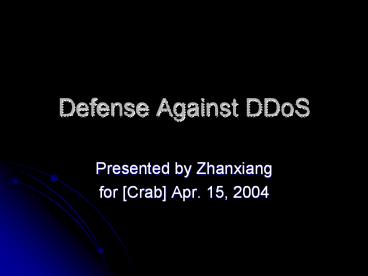Defense Against DDoS - PowerPoint PPT Presentation
Title:
Defense Against DDoS
Description:
DoS: 'an attack with the purpose of preventing legitimate users from using a ... sites' extortion fears, by Paul Roberts, IDG News Service, January 28, 2004 ... – PowerPoint PPT presentation
Number of Views:285
Avg rating:3.0/5.0
Title: Defense Against DDoS
1
Defense Against DDoS
- Presented by Zhanxiang
- for Crab Apr. 15, 2004
2
DoS DDoS
- DoS an attack with the purpose of preventing
legitimate users from using a victim computing
system or network resource 3 - DDoS A Distributed Denial of Service (DDoS)
attack uses many computers to launch a
coordinated DoS attack against one or more
targets. 4 - You may have paid for the hardware, but do you
really own your network?
3
Typical Attack Skill
- SYN Flooding
- IP spoofing
- Bandwidth attack
- Filling victims hard disk space
4
What can DoS lead to?
- Website
- DNS
- Mail Server
- Emergency
- Many tools are available for DoS attack and
teenagers must like to try them.2
5
Case Study
- DDoS attack hits clickbank and spamcop.net, by
Mirko Zorz, June 25, 2003 - Super Bowl fuels gambling sites' extortion fears,
by Paul Roberts, IDG News Service, January 28,
2004
6
Defense
- Two general area
- Defense against IP spoofing
- Defense against bandwidth flooding attack
- Turn to Lingxuan
7
Against Bandwidth Flooding Attack
- Goal stop attacks on their way to the victims
- Scheme SIFF1
8
SIFF Assumptions
- Marking space in the IP header.
- Routers mark every packet.
- Short-term Route Stability.
9
Idea
- Divide all traffic into
- Privileged Always get transfer
- Unprivileged Transferred if not affect
Privileged packets - Unprivileged -------------------gt Privileged
- handshake
- (to get the privilege token)
10
Idea (cont.)
- Routers
- mark packets in hand shakes
- match privilege token while forwarding packets
- Recipient refuse the attack flow by
- not providing the privilege token
- or provide a false one
11
Packet Identifier Design
- Flags field (3-bits).
- SF Packet is non-legacy
- PT EXP or DTA
- CU Capability reply present or not
- Capability Marks modified by routers
- C-R recipients to signal to sender a capability
12
Handshake
Client
Server
Routers
EXP(0)
Legend Packet-Type (Capability) Capability
Reply
EXP(a)
EXP(0) a
EXP(ß)a
DTA(!a)ß
DTA(!a)ß
13
Router Marking Calculation
IP of the Interface that at which the packet
arrived at
IP of the Last-hop routers outgoing interface
Keyed Hash Fun
Marking
Last z bits
Source IP and Destination IP of the packet
14
Marking Scheme for EXP
- Packets with a capability field of all zeros get
marked with an additional 1bit. - Routers push their markings into the least
significant bits of the capability field.
15
Authentication scheme for DTA
?
- Routers check the marking in the least
significant bits of the capability field, and
rotate it into the most significant bits, if it
is equal to what the marking would be for an
EXPLORER packet.
16
Key Switch
- Why?
- If the hash fun does not change periodically, an
attacker can simply obtain a capability through a
seemingly legitimate request, and then use it to
flood the server with privileged traffic. - Solution
- Windowed authentication and marking
17
Windowed authentication and Marking for DTA
- Routers check that the marking equals one of the
valid markings in its window and always rotate
the newest marking in the window into the
capability field.
18
Do Guesses work?
- x of markings each router maintains in its
window - z of bits per router marking
- P(x, z) probability that a randomly guessed
capability will pass a particular router.
19
Can Privilege Channel be Established Under
Unprivileged Packet Flooding?
- i hops of the network
- ei Probability of getting dropped at any one of
those routers
20
Limitations
- Depend on mechanism to detect attack
- Network with some router not implemented SIFF
- Colluding attacker
- Host granularity not application granularity
21
Reference
- 1 SIFF A Stateless Internet Flow Filter to
Mitigate DDoS Flooding Attacks. With Avi Yaar and
Dawn Song. Appears in 2004 IEEE Symposium on
Security and Privacy - 2 Tools http//staff.washington.edu/dittrich/mi
sc/ddos/ - 3 David Karig and Ruby Lee, Remote Denial of
Service Attacks and Countermeasures, Princeton
University Department of Electrical Engineering
Technical Report CE-L2001-002, October 2001. - 4 Lincoln Stein and John N. Stuart. The World
Wide Web Security FAQ, Version 3.1.2, February
4, 2002. http//www.w3.org/security/faq/ (8
April 2003).

